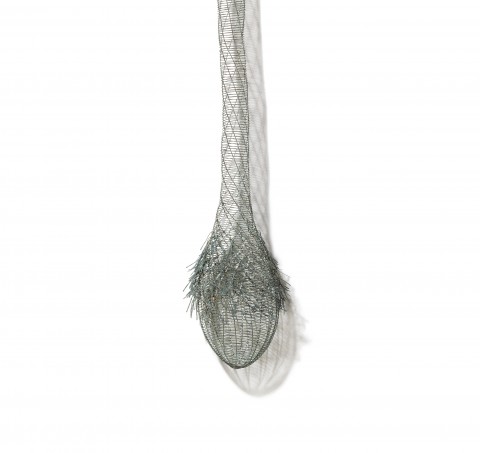VESSEL, 1991
BRONWYN OLIVER
copper and bronze
170.0 x 20.0 x 20.0 cm
Roslyn Oxley9 Gallery, Sydney
Private collection, Sydney, acquired from the above in 1994
Bronwyn Oliver: Fabrications, Auckland City Art Gallery Toi o Tāmaki, Auckland, New Zealand, 7 July – 20 August 1992, cat, 1
Bronwyn Oliver, Christine Abrahams Gallery, Melbourne, 8 September – 8 October 1992
Bronwyn Oliver, Roslyn Oxley9 Gallery, Sydney, 21 July – 7 August 1993
Fink, H., Bronwyn Oliver: Strange Things, Piper Press, Sydney, 2017, pp. 86, 219
Curlicue, 1991, copper, 45.0 x 250.0 x 15.0 cm, in the collection of Queensland Art Gallery | Gallery of Modern Art, Brisbane
Labyrinth, 1991, copper, 174.0 x 57.0 x 18.0 cm, in the collection of Auckland Art Gallery Toi o Tāmaki, Auckland, New Zealand
With striking simplicity and an ambiguous sexual charge, Bronwyn Oliver’s open-weave copper Vessel strains vertically, its flared mouth ready to receive intangible nourishment. In early 1991, the young sculptor first embarked on a series of long and thin vertical works. The resulting fabrications exhibited an elegant downward cascade, unfurling organically, or, like Vessel, 1991, a proud rectitude and optimistic verticality. Here, the central shaft, with discernible horizontal wire struts, is finely woven into a helix. It extends from a pendulous spherical base, ringed with hairs, to a mouth which simply gapes open, slightly askew. Like a pistil, the reproductive organ in the centre of a flower, the bulbous base of Vessel supports a long column topped by a flared opening, mirroring the stigma, where pollen is germinated. However, despite these formal associations with natural shapes, Oliver insisted that her works did not consciously stem from any personal investigations into organic morphology. Her verdigris sculptures are instead endowed with an otherworldly aura of mysterious antiquity.
Delicate and airy, its grid-like lattice fabricated from small-gauge copper wire, Vessel is as defined by its physical, handmade presence as it is by its absence, by the glimpses revealed through the perforations and the space enclosed within this helicoidal funnel and its pouch. Of a similar fishnet construction to the casual horizontal Curlicue, 1991, the regularity of Vessel’s lattice creates an optical rhythm, redoubled by its projected shadow. Ethereal and yet permanent, Vessel displays an improbable lightness of touch and what Elwyn Lynn identified as an ‘ease of drawing.’1 With slightly wobbly wire lines and a ‘natural’ fall that is not dead-straight, Vessel has a warm, handmade authenticity complementing its swollen, life-affirming shapes. Oliver’s abstract fabrications emphasised craftsmanship, their surfaces shaped by a profound respect for materials and their metaphorical properties – all hallmarks of the New British Sculpture Movement, which the artist had encountered during her time at the Chelsea School of Art in London in the early 1980s. Other practitioners at the forefront of this movement were Richard Deacon, Tony Cragg, Alison Wilding, Shirazeh Houshiary, Anish Kapoor and Antony Gormley.
In June 1991, Oliver presented some of her new vertical works in her solo exhibition at Roslyn Oxley9 Gallery, which was positively reviewed in the local Sydney newspapers. In August of that year, she participated in Perspecta, the only survey show for contemporary Australian art at the time. Victoria Lynn, writing in the catalogue noted that ‘the shadows they [Oliver’s sculptures] cast are clearly intrinsic to the structure of the pieces. Shadows echo and extend the spatial principles, negotiating the border between two-dimensionality and three-dimensionality, between surface and space, between image and structure.’2 Oliver used the relative density, direction and shapes within her metal weaving as a distinguishing feature between works of similar forms and dimensions. For example, Rope, 1991 adopts a very similar shape to Vessel, one with ‘the sense of a parable, of Rapunzel or Jack and the Beanstalk’3, only rendered with a dense wrapped surface. For those with a delicate and open weave, particularly Vessel’s optical grid, a strong frontal light casts a twin, flat shadow with the layers of Oliver’s three-dimensional form concertinaed into a complex image. This tension between Vessel’s fragile structure and its dense shadow is masterful and animates the subtle torsion inherent in Oliver’s woven helix.
1. Lynn, E., ‘Intimacy and nature’, The Australian, Sydney, 17 June 1989
2. Lynn, V., Australian Perspecta 1991, Art Gallery of New South Wales, Sydney, 1991, p. 78
3. Fink, H., Bronwyn Oliver. Strange Things, Piper Press, Sydney, 2017, p. 86
LUCIE REEVES-SMITH



